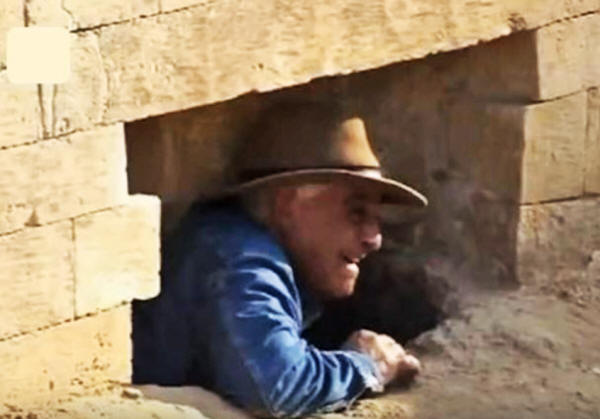|

by Ancient Code Team
September
26, 2017
from
AncientCode Website
Italian version

Is there really something like
"Forbidden Archeology?"
Or is it just
another concept highlighted by
conspiracy theorists to
suggest archaeologists do not present all of their
discoveries to the public?
Some would say it is just
nonsense, but there has been a great number of hushed-away
discoveries that suggest otherwise.
Many authors indicate that not all discoveries have been made public
when it comes to exploring ancient sites and monuments. Regrettably,
this can be said when we speak about the
Great Sphinx of Giza, or better said the entire Giza
plateau.
A great number of studies have been performed by various
institutions and archaeologists which have demonstrated that there
are many 'untold' secrets beneath the Giza plateau.
Just beneath the majestic
Pyramids of Egypt and the great Sphinx, we find a number
of cavities and chambers that have remained engulfed in mystery for
years.

It is said that these chambers hold answers that could help us
understand how
ancient civilizations developed in the past, and how
advanced they really were.
The Great Sphinx of Giza is interesting for a number of reasons...
First of all, it
holds the record as the largest monolith statue on the surface
of the planet and is also one of the most mysterious ancient
statues ever discovered on Earth.
We have no idea why it was built, who built it, how it was built
and what its true purpose really is.
In fact, we have almost no information about the Sphinx
whatsoever.

We learned a lot about
the Sphinx in 1987 when scientists from the
Waseda University
(Tokyo), under the direction of
Sakuji Yoshimura carried out
an electromagnetic sounding survey of the Khufu Pyramid and Sphinx.
They discovered something incredible:
SEVERAL cavities and
tunnels beneath Giza...
But where do these
cavities and tunnels lead?
What is inside them?
Who built them?
And what was their
exact purpose?
These answers remain an
enigma as a great amount of information about the Sphinx is mixed-up
in a cloud of mystery.
The Sphinx is NOT a solid monument in the inside
While many believe the Sphinx is solid from the inside,
experts from Japan found otherwise.
Scientists from the Waseda University
found that south of the Sphinx
are hollow parts on the ground and there are cavities ranging from 2
to 3 meters inside.
Furthermore, they also discovered a groove on
the Sphinx body that extends beneath the ancient monument.
Researchers discovered that to the north of the Sphinx were similar
grooves which indicate there could be a tunnel that leads underneath
the Sphinx, connecting the southern and northern cavities.
Furthermore, researchers from Tokyo discovered that there are hollow
cavities just in front of the paws of the Sphinx. These alleged
'rooms' lead below the monument into unexplored parts.
Japanese scientists concluded that the sanctuary of the Sphinx
contains more cavities below the Sphinx than were previously known.
(source
-
source -
reference)
So if these cavities, tunnels, and chambers really do exist,
Why
have we not explored them in more detail?
Why is it that whenever a
similar discovery is made, some scholars prefer to ignore the
findings instead of perusing their understanding?
In 1991 researchers performed another survey at the Sphinx.
They
confirmed the discoveries made in 1987 by researchers from the Waseda University.
Thomas Dobecki and John Anthony West explored the region surrounding
the Sphinx using,
-
seismic refraction
-
refraction tomography
-
seismic reflection
They discovered subsurface cavities in front of
the front left paw, and from the left paw back along the south
flank.
The scientific data mentioned above can also be corroborated by a
number of images - some of them extremely old - which show without a
doubt that there are entrances and tunnels leading beneath the
Sphinx.
These images are evidence of shafts and passageways leading towards
unexplored chambers underneath the Sphinx...


All of this seems to be backed up in the book
The Message of The Sphinx,
where authors Graham Hancock, and Robert Bauval state
that the Egyptian government together with American archaeologists
have blocked any investigations around and/or beneath the Great
Sphinx, preventing anyone from locating the underground cavities and
finding out what is located beneath the Sphinx and the Pyramids.
Oh and…
Did we forget to mention the fact that there is a great
amount of evidence that suggests
there was a SECOND Sphinx at Giza?
So if there is scientific evidence to support the idea that there
are secret chambers beneath the Giza plateau, and images back up the
entire story, why have we not explored these areas in more detail?
Is it really 'forbidden archaeology'?
Or are we just that
uninterested?
|






